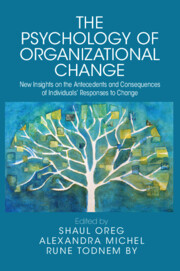 The Psychology of Organizational Change
The Psychology of Organizational Change Book contents
- The Psychology of Organizational Change
- The Psychology of Organizational Change
- Copyright page
- Contents
- Contributors
- Part I Introduction
- Part II The Evolution of Change and Its Responses
- Part III Change in Context
- Part IV The Development of Change Leadership
- Part V The Process of Change Leadership
- Part VI Conclusions and Commentary
- Chapter 13 Commentary
- Index
- References
Chapter 13 - Commentary
Developments in the Recognition of Crucial Roles of Change Dynamics
from Part VI - Conclusions and Commentary
Published online by Cambridge University Press: 28 September 2023
- The Psychology of Organizational Change
- The Psychology of Organizational Change
- Copyright page
- Contents
- Contributors
- Part I Introduction
- Part II The Evolution of Change and Its Responses
- Part III Change in Context
- Part IV The Development of Change Leadership
- Part V The Process of Change Leadership
- Part VI Conclusions and Commentary
- Chapter 13 Commentary
- Index
- References
Summary
Here I comment on the chapters that have formed the contribution of this volume. I note that this second edition makes contributions considerably beyond those of the first edition, in particular by devoting attention to the dynamics of planned organizational change, not simply its instigators and outcomes. In particular, the chapters contribute to several important themes associated with dynamics of planned change. These include ways of classifying types of organizational change, the importance of change leaders and the development of change leadership, the importance of both affective and cognitive processes (especially sensemaking) in change, the roles of several types of identity processes in change, and the recognition of temporal processes in change. The chapters show the salience of these dynamics, whether they are recognized or not, to sensitize scholars to look for them. I conclude by suggesting some possible new directions for future investigations of change. These include the use of process as well as variance theorizing, attention to change emergence, and attention to changes that extend beyond individual organizations.
Keywords
- Type
- Chapter
- Information
- The Psychology of Organizational ChangeNew Insights on the Antecedents and Consequences of Individuals' Responses to Change, pp. 291 - 307Publisher: Cambridge University PressPrint publication year: 2023


